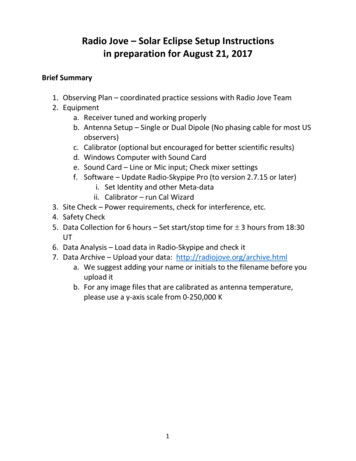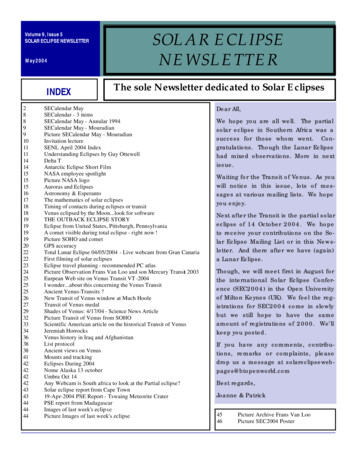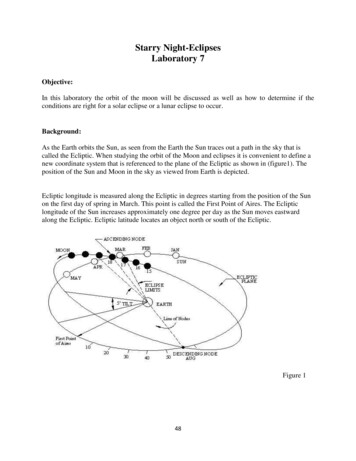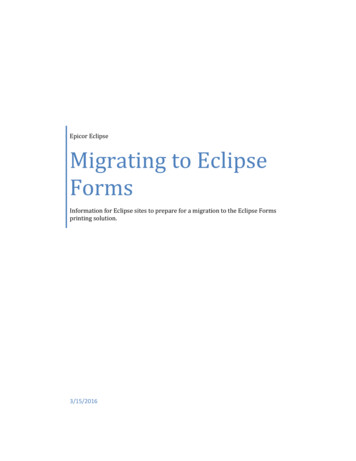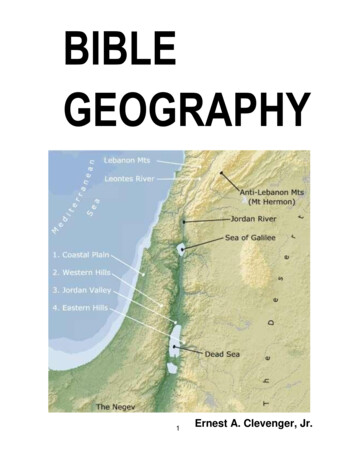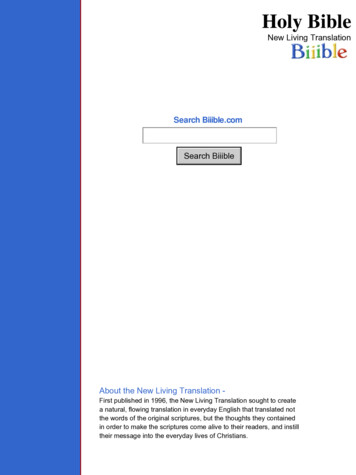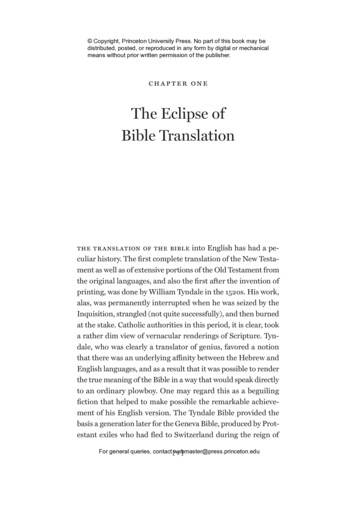
Transcription
Copyright, Princeton University Press. No part of this book may bedistributed, posted, or reproduced in any form by digital or mechanicalmeans without prior written permission of the publisher.CH A P T ER ONEThe Eclipse ofBible TranslationThe translation of the Bible into English has had a peculiar history. The first complete translation of the New Testament as well as of extensive portions of the Old Testament fromthe original languages, and also the first after the invention ofprinting, was done by William Tyndale in the 1520s. His work,alas, was permanently interrupted when he was seized by theInquisition, strangled (not quite successfully), and then burnedat the stake. Catholic authorities in this period, it is clear, tooka rather dim view of vernacular renderings of Scripture. Tyndale, who was clearly a translator of genius, favored a notionthat there was an underlying affinity between the Hebrew andEnglish languages, and as a result that it was possible to renderthe true meaning of the Bible in a way that would speak directlyto an ordinary plowboy. One may regard this as a beguilingfiction that helped to make possible the remarkable achievement of his English version. The Tyndale Bible provided thebasis a generation later for the Geneva Bible, produced by Protestant exiles who had fled to Switzerland during the reign ofFor general queries, contact [webmaster@press.princeton.edu1]Alter.indb 112/10/2018 7:21:16 AM
Copyright, Princeton University Press. No part of this book may bedistributed, posted, or reproduced in any form by digital or mechanicalmeans without prior written permission of the publisher.[2]CH A PTER ONEthe militantly Catholic Queen Mary. More decisively, in the firstdecade of the seventeenth century Tyndale became the modelfor the King James Version (1611). The translators convened byKing James took very many verses and countless phrases andclauses directly from Tyndale, but, even more important, heblazed a stylistic path for them even when they weren’t copyinghim. An instructive case in point is their translation of Ecclesiastes. It is one of their most memorable achievements, capturing much of the haunting prose poetry of the Hebrew withits beautiful cadences (even if some of the key terms, such as“vanity of vanities” and “vexation of spirit,” reflect a misunderstanding of the original). None of this is borrowed from Tyndale because he did not survive to translate Ecclesiastes, but inregard to diction and rhythm and the managing of many Hebrew idioms, he had given them an invaluable precedent.It took a century or more before the King James Bible became the fully canonical English version. By the nineteenthcentury it was entirely dominant—some of the major works ofAmerican literature in this era are unthinkable without thematrix of the King James language—and, despite the welter ofnew translations that have been produced from then down toour own time, the 1611 translation has shown a surprising degree of staying power. As recently as 2014, it was still the preferred Bible of 55 percent of the respondents to a broad survey.It had undergone several successive revisions beginning in thelater nineteenth century that mitigated the archaism of its language and corrected its more egregious translation errors whileunfortunately somewhat flattening its style, but the grandeurof the original version, even if some of its language is nowopaque, still clearly continues to appeal to a large number ofreaders. This preference for the King James Version is surelydictated in part by the woeful inadequacies of the twentieth- century English translations. Before considering the reasonsFor general queries, contact webmaster@press.princeton.eduAlter.indb 212/10/2018 7:21:16 AM
Copyright, Princeton University Press. No part of this book may bedistributed, posted, or reproduced in any form by digital or mechanicalmeans without prior written permission of the publisher.The Eclipse of Bible Tr a nsl ation[3]for this general decline, I would like to indicate briefly thegenuine virtues and also the shortcomings of what has for solong been our canonical English Bible.The committees—they were called “companies”—assembledunder the authority of King James were composed of scholarsand ecclesiastical figures with impressive credentials of erudition—many knew Arabic and Syriac as well as Hebrew, Greek,and Aramaic—who were also immersed in the literary cultureof their age. Launcelot Andrewes, the Anglican bishop who wasprobably the most influential figure among the company members, was one of the great prose stylists of the early seventeenthcentury, as his published sermons attest, and his fine commandof the language surely left its imprint on the translation. Themuch- celebrated eloquence of the King James Version is veryreal, and that, coupled with its royal authorization, must havehad a great deal to do with its rise to canonical status and withits profound influence on literary English.One of the signal strengths of the 1611 translation is what Iwould call its inspired (not divinely inspired) literalism. Theseventeenth- century translators worked with the theologicalconviction that every word of the Bible was revealed to humankind by God and that one didn’t play games with God’swords. A vivid typographical illustration of this conviction isthe use of italics that has often puzzled modern readers. (Inthe 1611 printing it was less confusing because these wordsappeared in a roman font that contrasted with the more or lessgothic font of the surrounding text.) The italics do not indicateemphasis, as they would in current practice, but rather theintroduction into the translation of a word that is merely implied in the original. To cite a very common example, Hebrewhas no present tense for the verb “to be.” To say “I am Joseph,”just two words are used—“I” (’ani) and “Joseph” (Yosef ). TheKing James translators, given their scruples, could not permitFor general queries, contact webmaster@press.princeton.eduAlter.indb 312/10/2018 7:21:16 AM
Copyright, Princeton University Press. No part of this book may bedistributed, posted, or reproduced in any form by digital or mechanicalmeans without prior written permission of the publisher.[4]CH A PTER ONEthemselves to write “am” as though it actually appeared in theHebrew, and so they set out the word in a different typeface toshow that it wasn’t literally in the Hebrew but had to be addedbecause of the necessities of English usage.The inspired literalism of the King James Version beginswith its representation of Hebrew syntax in the prose narratives. Biblical prose predominantly uses parataxis—that is, theordering of words in parallel clauses linked by “and,” with verylittle syntactic subordination or the accompanying subordinateconjunctions such as “because,” “although,” or “since” that specify the connection between clauses. (In some cases, however,there are clues of context or grammar that give this same Hebrew particle the sense of “but,” and in those instances translators are obliged to render it as “but.”) My guess is that the KingJames translators followed the Hebrew parataxis not chieflyout of a stylistic decision but because they thought that if thisis the order in which God put the Hebrew words, that ordershould be reproduced in English. In the Hebrew, parataxis isvery much an artful vehicle, generating imposing cadenced sequences of parallel clauses and often exploiting the lack ofcausal explanation of the relation between clauses to createthought- provoking ambiguities. This was not a normal way toorganize language in English, but it would become a strongliterary option after 1611. Most of this has been thrown out thewindow in the modern English versions, impelled by the misconception that modern readers cannot make sense of parataxisand that everything in the biblical text needs to be explained.There is another aspect of style for which the King Jamestranslators came to a happy solution that has been almost universally jettisoned by their modern successors. Biblical narrative makes do with a very small vocabulary. My own inferenceis that there was a conventional understanding that only a certain limited vocabulary could be used for narrative prose. OneFor general queries, contact webmaster@press.princeton.eduAlter.indb 412/10/2018 7:21:16 AM
Copyright, Princeton University Press. No part of this book may bedistributed, posted, or reproduced in any form by digital or mechanicalmeans without prior written permission of the publisher.The Eclipse of Bible Tr a nsl ation[5]principal reason for this inference is that there are many termsthat appear in poetry but never in prose. In biblical narrative,for example, there is only one word for light, ’or, together witha cognate, ma’or, that means “source of light” or “lamp.” Biblicalpoetry, on the other hand, exhibits a whole handful of moreelaborate or elevated words that would be the equivalents ofsuch English terms as “brilliance,” “radiance,” or “effulgence.”Telling a story rather than composing a poem in ancient Hebrew, you evidently were expected to refrain from such high falutin language and restrict yourself to the primary term ’or.By and large, the King James translators respected this stylisticpractice whereas their modern successors have been impelledeither to translate repeated terms differently according to context or to improve on the original by substituting a fancy andpurportedly literary term or an explanatory one for the homespun Hebrew word.Let me illustrate this lamentable trend in Bible translationwith two verses from Genesis (7:17–18). Here is the King JamesVersion: “And the flood was forty days upon the earth; and thewaters increased, and bare up the ark, and it was lift up abovethe earth. And the waters prevailed, and were increased greatlyupon the earth; and the ark went upon the face of the waters.”All this should be perfectly intelligible to the modern reader,with only the archaic form of two verbs a little strange. Now Iwill cite, in order, Protestant, Catholic, and Jewish translationsdone in the second half of the twentieth century. The RevisedEnglish Bible: “The flood continued on the earth for forty days,and the swelling waters lifted up the ark so that it was highabove the ground. The ark floated on the surface of the swollenwaters as they increased over the earth.” The New JerusalemBible: “The flood lasted forty days on earth. The waters swelled,lifting the ark until it floated off the ground. The waters rose,swelling above the ground, and the ark drifted away over theFor general queries, contact webmaster@press.princeton.eduAlter.indb 512/10/2018 7:21:16 AM
Copyright, Princeton University Press. No part of this book may bedistributed, posted, or reproduced in any form by digital or mechanicalmeans without prior written permission of the publisher.[6]CH A PTER ONEwaters.” The Jewish Publication Society: “The Flood continuedforty days on the earth and raised the ark so that it rose abovethe earth. The waters swelled and increased greatly upon theearth, and the ark drifted upon the waters.”It should be noted that all three modern versions do awaywith the parataxis of the Hebrew, introducing subordinateclauses (“so that . . .”) and participial phrases where the originalhas independent clauses. In this fashion, the grand rhythm ofparallel utterances is turned into something commonplace. Iwould especially like to direct attention here to the choicesmade for two verbs. The King James Version, faithfully following the Hebrew, has “the flood was forty days upon the earth”and “the ark went upon the face of the waters.” To the moderntranslators this evidently seemed too simple, and so instead of“was” they use “continued” or “lasted,” and instead of “went”they give us “floated” or “drifted.” Such substitutions seriouslycompromise the beautiful dignity of the Hebrew with its adherence to a purposefully simple lexicon of primary terms. (Thestylistic power of such simplicity was keenly understood byHemingway, who of course was strongly influenced by the KingJames Version.) The actual picture of what is happening withthe ark is also somewhat altered by these translators in theirdesire to “improve” it for the modern reader. One might perhaps infer that the ark was drifting, or drifting away, but theHebrew does not actually say that, and this leads readers to theconclusion that Noah’s ark was rudderless, which may or maynot have been the case. In any event, the grand simplicity of“the ark went upon the face of the waters” is entirely lost. Thereis a sense that the modern biblical scholars who produced theseversions drew on a literary experience limited to middlebrowmagazine fiction, and so they labored under the illusion thatthey were making the Flood story more vivid for modern readers by introducing such locutions as “swollen waters” (a phraseFor general queries, contact webmaster@press.princeton.eduAlter.indb 612/10/2018 7:21:16 AM
Copyright, Princeton University Press. No part of this book may bedistributed, posted, or reproduced in any form by digital or mechanicalmeans without prior written permission of the publisher.The Eclipse of Bible Tr a nsl ation[7]that might appear in a conventional short story about the Mississippi flooding) and the ark drifting away. These translationsare also informed by what I would characterize as a rage toexplain the biblical text. Elsewhere, I might add, the impulseto explain through translation has still more dire consequencesbecause it becomes an explanation to make the Bible conformto modern views or modern ideologies. In the present instance,the translators, apprehensive that readers might not understand what happens when the rain comes down and the watersgo up, bearing the ark on their surface, spell out the mechanicalsteps of the process in explanatory subordinate clauses—“sothat it was high above the ground,” “until it floated off theground,” “so that it rose above the earth.” This is manifestly nothow the biblical writers chose to tell their stories.This celebration of the achievement of the King James Version requires some serious qualification. There are two problems with the 1611 translation that are scarcely its fault. TheEnglish language, of course, has changed both lexically andgrammatically in the course of four centuries. Apart from students of Renaissance literature, not many readers today willknow, for example, that “froward” means “perverse” or “contrary,” and that “ward” means “prison” or “custody.” There is notmuch to be done about such difficulties except annotation,something Herbert Marks has provided in his splendid NortonCritical Edition of the King James Old Testament. The otherpervasive problem with our canonical English version is thatthe seventeenth- century translators, for all their learning, hada rather imperfect grasp of biblical Hebrew. At times they getconfused about the syntax, and they repeatedly miss the nuance, or even the actual meaning, of Hebrew words. Usuallythis is a matter of being slightly off or somewhat misleading, aswhen, following the Vulgate, they transpose concrete Hebrewterms into theologically fraught ones—“soul” for nefesh, whichFor general queries, contact webmaster@press.princeton.eduAlter.indb 712/10/2018 7:21:16 AM
Copyright, Princeton University Press. No part of this book may bedistributed, posted, or reproduced in any form by digital or mechanicalmeans without prior written permission of the publisher.[8]CH A PTER ONEactually means “essential self,” “being,” “life- breath,” or “salvation” for yeshu‘ah, which means “rescue,” “getting out of a tightfix.” Sometimes, alas, there are real howlers. In the mysteriouscovenant between God and Abram in Genesis 15, the 1611 version reads “an horror of great darkness fell upon him,” becausethey have taken an adjective, ḥ asheikhah to be the noun it formally resembles. The Hebrew actually says “a great dark horrorfell upon him,” with no suggestion that Abram our forefatherwas afraid of the dark. Still more egregiously, in Job 3:8 weencounter cursers of the day “who are ready to raise up theirmourning.” The Hebrew in fact says “raise up Leviathan.” TheKing James translators misread the mythological beast leway atan as the rabbinic word for “funeral,” lewayah, not distinguishing between biblical and rabbinic Hebrew, and overlooking the fact that the word as they incorrectly construed it wouldhave an inappropriate feminine possessive suffix. Such errorsare probably understandable because Hebrew was a book language for them, cultivated for barely a century by Christianhumanists. By contrast, the great Hebrew commentators of theMiddle Ages, such as Rashi and Abraham ibn Ezra, were immersed in Hebrew, thought in Hebrew, and—in the case of ibnEzra—wrote poetry in Hebrew, and consequently had a muchfirmer command of syntax, grammar, and lexical nuance.There is also a stylistic issue with the King James Version.It may be a little surprising to say that its treatment of poetryis by and large less successful than its representation of narrative prose. I would argue that this is often the case even whenthe lines of verse exhibit persuasive force, as they famously doin Psalms. Let me cite an instance that most English speakersknow by heart, from the twenty- third psalm: “Yea, though Iwalk through the valley of the shadow of death, I will fearno evil.” This is grand, but the grandeur is nothing like theHebrew. Instead of eight words and thirteen syllables, gamFor general queries, contact webmaster@press.princeton.eduAlter.indb 812/10/2018 7:21:16 AM
Copyright, Princeton University Press. No part of this book may bedistributed, posted, or reproduced in any form by digital or mechanicalmeans without prior written permission of the publisher.The Eclipse of Bible Tr a nsl ation[9]ki ’elekh begei’ tsalmawet lo’ ’ira r‘a, we are given seventeenwords and twenty syllables. The power of biblical poetry inheres in its terrific compactness. The King James translators,attached to a more orotund and expansive Jacobean rhetoric,rarely produce English equivalents of this compactness. TheEnglish line from Psalms is a memorable line of poetry, but,stretching from margin to margin on the page, it reads morelike a line from Walt Whitman (who of course was profoundlyinfluenced by the King James Psalms) than like a line of ancientHebrew verse. The underlying problem, I suspect, is that theKing James translators, though they had an impressive feel forEnglish, approached biblical Hebrew as a language to be deciphered from the printed page, and they often did not seem tohear it.Here is a line of poetry from Job (3:11) that instructivelyillustrates both the remarkable stylistic strength and the weakness of the King James Version. The first half of the line—linesof biblical poetry usually show two inter- echoing halves, or“versets”—could scarcely be improved on: “Why died I not fromthe womb?” The Hebrew is lamah lo’ mereḥ em ’amut. As atranslator, I envy the freedom of the King James collaboratorsto use a compact syntactic inversion, “died I not,” whereas,working in the twenty- first century, I felt constrained to adoptthe clumsier “did I not die.” But in the second half of the line,alas, the translation unravels: “Why did I not give up the ghostwhen I came out of the belly?” These fifteen words—all but onemonosyllabic but nonetheless arhythmic—represent threewords, eight syllables, in the Hebrew: mibeten yatsa’ti we’eg wah. The meaning of the Hebrew is there, but the poetry getslost in the verbiage. My own approximation of the Hebrew is“from the belly come out, breathe my last.” For the three finalwords, “expire” would have been rhythmically preferable, butit seemed to me too abstract and Latinate for the diction of theFor general queries, contact webmaster@press.princeton.eduAlter.indb 912/10/2018 7:21:16 AM
Copyright, Princeton University Press. No part of this book may bedistributed, posted, or reproduced in any form by digital or mechanicalmeans without prior written permission of the publisher.[ 10 ] CH A PTER ONEpoem. As elsewhere, there is both gain and loss in translationchoices.The King James Bible, then, remains an imposing achievement, yet as I have indicated, it has its drawbacks. But whyhave English translators in our age fallen so steeply from thisgrand precedent? To begin with, I would note a pronouncedtendency among them to throw out the beautiful baby with thebathwater. Those companies convened by King James, theirmodern successors assume, got it altogether wrong. We mustnow start from scratch, swerve away sharply from all that theydid, treat biblical syntax in an informed way that can speak tomodern readers, represent biblical terms with what we understand to be philological precision according to their shiftingcontexts, and make things entirely clear for people who wantto know what the Bible is really saying. This impulse is misconceived on two grounds. First, the Bible itself does not generallyexhibit the clarity to which its modern translators aspire: theHebrew writers reveled in the proliferation of meanings, thecultivation of ambiguities, the playing of one sense of a termagainst another, and this richness is erased in the deceptiveantiseptic clarity of the modern versions. The second issue isthe historical momentum of the commanding precedent created by the King James Bible. It has been such a powerful presence for four centuries of English readers that a translation ofthe Bible that proceeds as though it simply didn’t exist becomeshard to read as a version of the Bible that has any literary standing. I don’t mean to advocate a direct imitation of the KingJames Bible, but I would propose that for an English translation to make literary sense it somehow has to register the stylistic authority of the 1611 version, or, one might say, it needs tocreate a modern transmutation of how the King James translators imagined the Bible should be rendered in English. WhenStendhal was working on The Charterhouse of Parma, he notedFor general queries, contact webmaster@press.princeton.eduAlter.indb 1012/10/2018 7:21:16 AM
Copyright, Princeton University Press. No part of this book may bedistributed, posted, or reproduced in any form by digital or mechanicalmeans without prior written permission of the publisher.The Eclipse of Bible Tr a nsl ation[ 11 ]that he would like it to read like Fielding’s Tom Jones—not ofcourse, he hastened to say, like the Tom Jones of the eighteenthcentury but as an equivalent to the style of that novel as it mightbe written in the 1830s, and that, I would propose, is what modern translators of the Bible should try to do in relation to theKing James Version.Equally important as a reason for the gravely flawed moderntranslations of the Bible is a problem of what might be characterized as the sociology of knowledge. Modern translators ofScripture are almost all rigorously trained at a few premieruniversities that have well- established programs in biblicalstudies. In the United States, these would include Harvard,Yale, Johns Hopkins, the University of Pennsylvania, and theUniversity of Chicago. Doctoral students at these august institutions acquire the tools of philological analysis, study the complex evolution of the biblical texts, learn Akkadian, Ugaritic,and in some cases, Egyptian as well. All this is certainly helpfulfor reconstructing the elusive meanings of writings removedfrom us by nearly three millennia. The general commitment,however, to eliciting clarity from much that is obscure has theunfortunate consequence for translation of introducing clarifications that compromise the literary integrity of the biblicaltexts. One manifestation of this tendency, to which I have already alluded, is the practice of repeatedly assigning the sameHebrew term different English equivalents according to thecontexts in which it appears, a practice that sometimes may beunavoidable but often is not. Another consequence of the impulse for clarification is to represent legal, medical, architectural, and other terms from specific realms of experience inpurportedly precise modern technical language when the Hebrew by and large hews to general terms (the priest in Leviticus, for example, “sees” the symptoms of a skin disease whilein the modern translations he “inspects” them).For general queries, contact webmaster@press.princeton.eduAlter.indb 1112/10/2018 7:21:16 AM
Copyright, Princeton University Press. No part of this book may bedistributed, posted, or reproduced in any form by digital or mechanicalmeans without prior written permission of the publisher.[ 12 ]CH A PTER ONEThough the training of modern biblical scholars is quitestrong in exploring all the ancient Near Eastern contexts relative to the Bible, attention to the literary aspects of the Bible,which are essential to understanding it, plays no role at all inthis training. Granted, there have been efforts in recent decadesby some biblical scholars to bring to bear literary perspectivesin their work, but these remain marginal in the field. It is stillinconceivable for a course to be offered in prose style or narrative conventions in any of the major institutions where thereare programs in Hebrew Bible. Moreover, the scholars, largelytrained in the middle decades of the previous century, who produced the various modern English versions would never havedreamed of addressing such questions. Literary style, then, isnever studied, and the translators consequently proceed as ifthe Bible had no style at all, as if a translator were entitled torepresent it in a hodgepodge of modern English styles. Theconventions and techniques of biblical narrative, which aremanifested in crucial word choices by the Hebrew writers, as Ihave noted, have no part in the curriculum of biblical studies,and, with just a few exceptions, the same is true of the forms ofbiblical poetry—a deficiency that is even visible typographicallyin the modern translations, which often lay out lines of versearbitrarily in breaks that do not correspond to the actual Hebrew lines.The blindness to the literary dimension of the ancient textsalso compromises biblical philology as it is taught in these institutions and then reflected in the translations of their graduates. Recovering the meanings of biblical words is conceived asa matter of establishing lexical values, and very little thoughtis given to nuance, connotation, or level of diction. In the story,for example, of the rape of Tamar in 2 Samuel 13, the nounbiryah and its cognate verb, repeatedly used in this episode andvery rare elsewhere, is regularly represented by the modernFor general queries, contact webmaster@press.princeton.eduAlter.indb 1212/10/2018 7:21:16 AM
Copyright, Princeton University Press. No part of this book may bedistributed, posted, or reproduced in any form by digital or mechanicalmeans without prior written permission of the publisher.The Eclipse of Bible Tr a nsl ation[ 13 ]translations, quite blandly, as “food.” This is not, however, thenormal biblical term for “food,” and an inspection with the aidof a Hebrew concordance of all its occurrences reveals that it isinvariably food offered to someone who has been fasting or whohas been for some reason doing poorly, as Amnon in this storypretends to be doing. Thus an English equivalent such as“nourishment,” which fits the narrative context and distinguishes this word from the usual term for “food,” is required.What this example should suggest is that you cannot determine the meanings of biblical words without taking into consideration their narrative or poetic contexts. The example from2 Samuel 13 is an instance of missed nuance, but there are othercases in which the translators altogether misconstrue themeaning because of their insensitivity to the bearing of the narrative on the term. A striking case is the universal mistranslation of a rare Hebrew term, ḥ alitsot, in the Samson story(Judges 14:19). All the modern translators labor under the misapprehension that the reference is to a garment—the JerusalemBible: “what they wore”; the Jewish Publication Society (telescoping two different words in the Hebrew): “sets of clothing”;the Revised English Bible, quite fancifully, with no philologicalwarrant, “their spoils.” Now, this Hebrew word is followed immediately in the text by another that sounds a little like it,ḥ alifot, which unambiguously means “changes of garments.”Samson’s wager with the Philistine wedding guests had beenthat if they solved his riddle, he would give all thirty of themḥ alifot begadim, “changes of garments.” The translators all assume that ḥ alitsot also must mean some sort of garment. Instructively, ḥ alitsot as something worn, but not really a garment, appears just one other time in the Bible. In 2 Samuel2:21, when Saul’s general Abner is being pursued on the battlefield by the swift- footed Asahel, Abner tells him, “Swerve youto your right or to your left and seize for yourself one of the lads,For general queries, contact webmaster@press.princeton.eduAlter.indb 1312/10/2018 7:21:16 AM
Copyright, Princeton University Press. No part of this book may bedistributed, posted, or reproduced in any form by digital or mechanicalmeans without prior written permission of the publisher.[ 14 ] CH A PTER ONEand take you his ḥ alitsah” (2 Samuel 2:21). The Revised English Bible people think this is a “belt”; the Jewish PublicationSociety proposes “tunic”; the Jerusalem Bible again fudges with“spoil.” But any reader of the Iliad knows that what a warriortakes from his slain foe on the battlefield is not an item of apparel but his armor. (The King James translators actually gotthis right, perhaps because, unlike their successors, they weregood readers of Homer, as were the Septuagint translatorswhom they followed, although they miss the meaning in theSamson story.) The r
Bible Translation The TrAnslATion of The BiBle into English has had a pe-culiar history. The first complete translation of the New Testa-ment as well as of extensive portions of the Old Testament from the original languages, and also the first after the invention of printing, was done by William Tyndale in the 1520s. His work,



